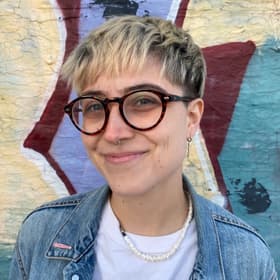Share
Framing fintech: chatting with fintech founder & investor, Aaron Frank, pt 1
Nov 30, 2022

In this blog series, Framing Fintech, our GM of Fintech and former Head of Growth at Ramp, Charley Ma, catches up with leaders in the industry to chat through lessons learned, fintech trends, and hot takes.
In the new edition of Framing Fintech, Charley Ma sat down with Aaron Frank to get his advice on how new credit card startups should approach launching a credit product.
Aaron Frank is an advisor, consultant, and investor to many fast-growing fintech companies and a longtime friend of Alloy. He runs a project called Not a Fintech Company, which is aimed at democratizing information in the financial services industry to enable people to build and run fintech companies more efficiently. Previously, Aaron was the co-founder and CEO of the credit card startup Final, which was acquired by Goldman Sachs. Aaron stayed on with Goldman Sachs to help them launch the Apple Card.
Get a bird’s eye view into their conversation below.
At a glance
An introduction to Aaron’s experience in fintech
Discussing Aaron’s background in fintech, including founding the credit card company Final and launching Goldman’s Apple Card
Fintech architecture in 2022 vs. fintech architecture in 2014
Why fintech is the only trillion-dollar industry where most of it is tribal knowledge
Breaking down Fintech waves - 1.0, 2.0, 3.0 and 4.0
What you should be thinking about if you’re building a new credit product
The varying levels of complexity for different types of card products
How to think product differentiation in a saturated market
Where your “secret sauce” is should influence your tech stack decisions
Why compliance and fraud are day-1 problems
The core competencies of a credit card: core processor technology, a credit product, risk, capital debt funding, a whole customer service organization, a marketing and acquisition engine
What you need to have live before you launch
Why there is no “instagram of fintech” so far and why a lot of launching a card is complexity management
The unit economics that actually matter for a credit card business
The unit economics that matter is business model dependent, and sales and marketing strategies have to be aligned to the business model accordingly
CHARLEY MA:
Can you give a quick introduction to yourself and your experience in fintech?
AARON FRANK:
In 2014, I started a company called Final. We were a full-stack credit card issuer. We built Final for four years, raised a bunch of venture money, and ultimately sold it to Goldman Sachs at the end of 2017. I joined Goldman and helped them turn our product into the Apple Card.
Now, I advise a handful of fintech companies and have invested in about 50+ fintech companies.
CHARLEY MA:
How would you describe the state of fintech architecture when you were starting Final in 2014? How does that compare to what you’re seeing today in 2022?
AARON FRANK:
The biggest thing is that now everything’s an API. Back then, I remember, when we went out and asked people for API docs, they said we can give you the table of contents after you sign an NDA, but we won’t give you the actual API until you’ve signed a contract. And we said, ‘What do you mean you can’t show us what we’re integrating with until we’ve signed a multi-year, potentially millions of dollars contract with you?’
So the market has fundamentally shifted to be more open and transparent, but if you think of fintech as “financial + technology,” the “fin” part of this industry still is not written down. Fintech is the only trillion-dollar industry where most of it is tribal knowledge.
So 2014 was like the heart of Fintech 2.0, and 1.0 was the OGs like Simple, PerkStreet, and TxVia. Fintech 3.0 happened while I was at Goldman, and now we’re approaching a new wave of Fintech 4.0, where you can spin something up in three months — with the Lithics, Highnotes, and the Units in the world —and have a product be moving money around without any direct bank partnership, without having to have a full compliance team in-house, with a lot of automation. In theory, you could do it with just an engineer.
Back then, you had to go scour the world for people who even understood how financial services worked. You’d go talk to someone like the former CTO of a bank, and you’d share how you built your infrastructure and how your business works, and they would share with you how they did it previously. After an hour, you’ve learned so much, but you also only learned it through the lens of that bank. So there was no democratization of how this industry functions from technology, operations, or even product builds.
Product innovations at the time were heavily focused on ‘how do I issue a different rewards card?’ Or, ‘how do I get more money out of my rewards program so that I have better margins, but maybe I can get my customers cheaper flights since I’ll also be the travel agent.’ Which is what AmEx has done and what Chase does now.
It was the wild west. There were a lot of us trying, in retrospect, but also only a handful of us making progress.
It took two and a half years to launch our company, which in retrospect, was a long time. We went through two processors and more than two bank partners, but we only ever really signed with two. And so, you kind of have to piece it all together. Even something that you’d think would be table stakes — like finding a law firm that knew how to negotiate and structure a contract for you — was challenging.
CHARLEY MA:
So now, what would you say if I came to you and was like, ‘I want to build a credit card. Aaron, what should I be thinking about?’
AARON FRANK:
I’d start by asking you what's your end goal. Fundamentally, mass-market credit cards are kind of misaligned with our customers, right? It’s kind of funny that banks keep your money safe — they give you a savings account — but they also give you a credit card where their goal is to make money off you from nickel and diming, fees, and interest charges.
So one of the first questions I ask is if you are modeling credit, it’s important to be clear with what type of card product you are - are you a credit card or a charge card or something else? The nuance is so important because if you’re offering a charge card, then you don’t have a lending business; there are no capital markets. I kind of have a structure that lays out the different normalized complexity levels for the different types of businesses: savings accounts are 1x complexity, debit accounts are about 4x complexity, charge is maybe 6x complexity, and credit is about 10x complexity.
When someone says, “So I want to build a new credit card product,” I ask them, “What is the new product?” In fintech, we talk about products in two ways. We talk about product in terms of UI / UX. And we talk about product from a fintech product perspective — what is your financial product with APR, credit line, etc.? I kind of ignore anyone that says UI/UX because I think, over time, that normalizes. But if you can bring me a true new fintech product — new either by mashing things together in an interesting way, which is really the most common way I see it done. Or, if you come up with some new idea that, for some reason, no one has come up with yet today. Then that’s really exciting.
From there, it depends on where they want to go. In the credit card world, if you think about how Capital One spent something like 2.8billion dollars a year in just marketing spend, you’re not going to out-compete them in the mass market. You can’t even go after a segment they’re going after because they effectively touch every single American something like three times a year with direct mail — that’s how much direct mail they send.
So you need to have a moat to start, and hopefully, it’s a durable moat. So to use auto secured credit as an example, there’s headline risk with some banks because it's close to title lending. No bank is going to touch a title loan anything, so you’ve entirely segmented that out. You’re still getting into a pretty massive TAM of people who are either unbanked, de-banked, subprime — people that can’t get a good loan, so you’re taking this kind of secured lending and bringing it to them in a way that works for both of you. From a capital structure for you, and for them, a 20% APR is 10x better than 300%.
So when somebody comes to me, it’s like - okay, but what are they doing that is demonstrably different? If they just say “alternative data,” that’s not enough for me.
CHARLEY MA:
How early do you recommend founders start thinking about their tech stack? What parts of the stack are must-haves that you really need to have in place? How do you recommend people think about picking vendors?
AARON FRANK:
There's very little you can delay because your bank partner won’t allow it anymore. If you went to market without some collections plan, even if it's not first-party and working with a TrueAccord, you’re not going to be able to do it.
It becomes a question of where you think your secret sauce is. If you don't think that technology is your secret sauce, see how much you can outsource with the right margins.
At Final, we viewed it as there are seven core competencies of a credit card: core processor technology, credit product, risk or capital debt funding, a whole customer service organization, a marketing and acquisition engine, and you also have what we call a traditional consumer product. All of this wraps around this kind of compliance organization that needs to make sure that none of these people screw up and do anything that gets you in hot water from a bank perspective, a regulatory perspective, and a legal perspective.
Honestly, I tell people to go out and do all that homework. If you’ve done the research, you’ll have a stronger play from anyone else getting funded and just copying you. If we’re talking about a true credit card, there’s a reason it’s 10x more complex. You have to do all these things to issue your first card. The second card is 1,000x easier. The first card is a million dollars of work and the second card costs $5.50.
CHARLEY MA:
What are the core components of the tech stack that founders should be thinking about when they’re launching a credit card?
AARON FRANK:
One of my consultant friends built a document when he was trying to win some business called Credit Card Trunk. It lays out all of the different pieces you need to build a credit card program. It’s a lot. Each one has multiple dimensions inside of it. You need a disaster recovery plan and business continuity just to make sure that this 24/7 product always keeps on working.
CHARLEY MA:
What do you need to have live already when you launch?
AARON FRANK:
You have to have an understanding of what each of the components in that document is and how each of them impacts your business. There's the whole control and compliance. You'll need the policies and procedures in place. You might not need to have fully operationalized everything, but you need to know what to do in different situations.
There's no “Instagram of fintech” so far because you can’t outsource a lot of these things because a lot of these have a big impact on your overall economics. If you get your core processor contract wrong, you could end up paying 2x as much, which will have a downstream impact of you not being able to invest as much in marketing and the payback period of a customer being longer, which means your LTV is lower. Everything flows together. A lot of fintech is a complexity management product. The core premise of this industry has existed for decades.
CHARLEY MA:
What are the unit economics that actually matter for a credit card business?
AARON FRANK:
I hate to say it's portfolio dependent, but if you're talking like superprime, there is always still debt on the books because there are always overdue payers. But, that's going to be a quarter to a third interest income and mostly fees and interchange. As you go to those segments, you're looking at annual fees on cards and stuff like that because the value prop is kind of like, ‘We're going to give you Global Entry. We're going to give you lounge access.’ They’re kind of playing the gym membership game, which is that people will sign up for the card and never cancel it. So an aggregate over the next X years, you'll probably get enough value out of the card, but you won't ever cancel it.
It just kind of depends. Unit economics also change if you're doing something kind of niche, like if you're trying to provide a loyalty program tied to some other brand. But then you're also talking about having to give away marketing incentives and other kinds of acquisition things and getting people through the funnel. So there is no strong rule.
But… you know, if you find a channel that has no acquisition cost, then you have essentially free money. There are operational costs, though, none of these accounts costs nothing to run a year.
There’s lot more to talk about! Check out part two of Charley and Aaron’s conversation here.




